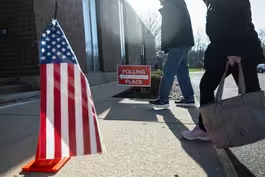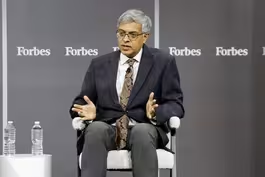
'Brains and Beauty' explores how the mind processes art
Clip: 11/27/2024 | 6m 15sVideo has Closed Captions
'Brains and Beauty' exhibit explores how the mind processes art and aesthetic experiences
Visual art is a subjective experience, but what draws one person into an artwork and turns off another? A new exhibit, "Brains and Beauty: At the Intersection of Art and Neuroscience," explores that question by examining how the brain processes aesthetic experiences. Stephanie Sy reports from Arizona for our look at the intersection of art and health, part of our arts and culture series, CANVAS.
Problems playing video? | Closed Captioning Feedback
Problems playing video? | Closed Captioning Feedback
Major corporate funding for the PBS News Hour is provided by BDO, BNSF, Consumer Cellular, American Cruise Lines, and Raymond James. Funding for the PBS NewsHour Weekend is provided by...

'Brains and Beauty' explores how the mind processes art
Clip: 11/27/2024 | 6m 15sVideo has Closed Captions
Visual art is a subjective experience, but what draws one person into an artwork and turns off another? A new exhibit, "Brains and Beauty: At the Intersection of Art and Neuroscience," explores that question by examining how the brain processes aesthetic experiences. Stephanie Sy reports from Arizona for our look at the intersection of art and health, part of our arts and culture series, CANVAS.
Problems playing video? | Closed Captioning Feedback
How to Watch PBS News Hour
PBS News Hour is available to stream on pbs.org and the free PBS App, available on iPhone, Apple TV, Android TV, Android smartphones, Amazon Fire TV, Amazon Fire Tablet, Roku, Samsung Smart TV, and Vizio.
Providing Support for PBS.org
Learn Moreabout PBS online sponsorshipWilliam: Experiencing art is a highly subjective experience.
What draws one person to a given work can completely turn off somebody else.
There is a new exhibit about the intersection of art and neuroscience that explores how our brains process aesthetic experiences.
This is part of our ongoing look at the intersection of health and art.
>> On a recent evening at Scottsdale, a neuroscientist at a museum educator led a tour of an art exhibit exploit intersection of beauty and the brain.
He's a leader in the field of narrow aesthetics, which sees how the brain experiences beauty.
>> Is one of the more important things that we react to.
We react to people based on how they look.
We react to our environments.
This is a fundamental aspect of what it means to be human.
Reporter: D exhibit is a visual exploration of this field.
It asks some meta-questions.
What is our brain doing when we look at art?
>> One of the things we are trying to do is try to give people some tools to look at art that is informed by research.
This is where the idea comes from.
Reporter: It is a system for engaging in an artwork.
Typically when you have this, you are activating all three at the same time.
I grouped it into those three categories.
I chose artwork that strongly represents this.
She curated this exhibit.
She had always been curious about what draws people to certain pieces.
>> I found out that science is asking the same question.
We have been asking the same questions.
Reporter: The exhibit contains pieces that may be more objectively pleasing to the iPad there are discordant objects in the show that might cause one to question what the aesthetic is at all.
>> I wanted to bring in a piece that will confuse you.
Reporter: This painting might be more accessible to the average viewer.
It is a rendition of the brain.
>> Is him in profile.
It is deep in the front-end in the center of your brain.
Reporter: It is an area of the brain that shows increased activity when a person is resting or engaged in personal reflection.
There was a state she was in at times.
>> I would like people to challenge their way of looking at the brain.
Experiencing it.
Communicating and sharing.
That is how we learn and grow.
Reporter: His work explores what is at stake when we think about beauty in society.
>> We discriminate things pretty well.
That is a problem.
People who are attracted get higher pay.
They get hired more easily.
Reporter: He is hoping that exhibit visitors will come away with tools to engage more deeply with the world.
William: That is the goal.
We think this is a vehicle for self-discovery.
What is it telling you about yourself?
This becomes a vehicle for people.
Reporter: The exhibit runs through mid-january.
♪
How psychology can help bridge divisions this Thanksgiving
Video has Closed Captions
Clip: 11/27/2024 | 10m 14s | Exploring how psychology can help bridge political divisions this Thanksgiving (10m 14s)
Israeli-Hezbollah deal learns from past, negotiator says
Video has Closed Captions
Clip: 11/27/2024 | 9m 52s | Israeli-Hezbollah cease-fire avoids mistakes of the past, U.S. negotiator says (9m 52s)
Trump names COVID lockdown skeptic to lead NIH
Video has Closed Captions
Clip: 11/27/2024 | 6m 54s | Trump names COVID lockdown skeptic to lead NIH, another sign of shifts in key agencies (6m 54s)
Trump's win signals acceptance of authoritarian leadership
Video has Closed Captions
Clip: 11/27/2024 | 6m 9s | How Trump's reelection signals a broader acceptance of authoritarian leadership (6m 9s)
Ukraine takes harsh measures to force draft dodgers into war
Video has Closed Captions
Clip: 11/27/2024 | 6m 26s | Lacking manpower, Ukraine resorts to harsh means to force draft dodgers into combat (6m 26s)
Providing Support for PBS.org
Learn Moreabout PBS online sponsorshipSupport for PBS provided by:
Major corporate funding for the PBS News Hour is provided by BDO, BNSF, Consumer Cellular, American Cruise Lines, and Raymond James. Funding for the PBS NewsHour Weekend is provided by...
















